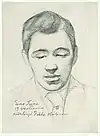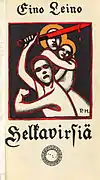Eino Leino
Eino Leino (born Armas Einar Leopold Lönnbohm; 6 July 1878 – 10 January 1926) was a Finnish poet and journalist who is considered one of the pioneers of Finnish poetry. His poems combine modern and Finnish folk elements. Much of his work is in the style of the Kalevala and folk songs in general. Nature, love, and despair are frequent themes in Leino's work. He is beloved and widely read in Finland today.
Eino Leino | |
|---|---|
 Eino Leino in 1912 | |
| Born | Armas Einar Leopold Lönnbohm 6 July 1878 Paltamo, Finland |
| Died | 10 January 1926 (aged 47) Tuusula, Finland |
Early life
Eino Leino was baptized as Armas Einar Leopold Lönnbohm in Paltamo as the seventh and youngest son in a family of ten children. Leino's father had changed his surname from Mustonen to Lönnbohm to improve his chances of marrying his future upper-class wife.[1] Eino's older brother Kasimir Leino was an important cultural figure in Finland. He was a poet, critic, and theatre director. Eino and Kasimir Leino founded a literature journal together in 1898.[2]
Leino published his first poem at the age of 12 and a collection of poems, Maaliskuun lauluja, at 18.[2]
Leino's parents died while he was still in school. He started school in Kajaani and continued in Oulu and Hämeenlinna, where he boarded with relatives. After graduating from the Hämeenlinna secondary school, Leino started studying at the University of Helsinki.[2]
Writing career

Early in his career Eino Leino was much loved and praised by the critics. He joined literary and newspaper circles and became a member of the Young Finnish circle. Among Leino's friends were the artist Pekka Halonen and Otto Manninen, who gained fame as a poet and translator.[3]
After the Finnish Civil War, Leino's idealistic faith for national unity collapsed, and his influence as a journalist and polemicist weakened. He was granted a State writer's pension in 1918 at the age of forty. Although publishing prolifically, he had financial problems and his health deteriorated. "Life is always a struggle with eternal forces," Leino said in a letter in 1925 to his friend Bertel Gripenberg.[3]

Leino published over 70 books of poems and stories. The most famous of these are the two poem collections Helkavirsiä (1903 and 1916), in which he extensively uses Finnish mythology and folklore.[3]

In addition to writing poetry, Eino Leino wrote in newspapers about theatre and culture in general, and translated works of important writers such as Runeberg and Goethe.[2] He was the first person in Finland to translate Dante's Divine Comedy into Finnish.[3]
Leino was married three times and had one daughter, Helka. He died in 1926 at the age of 47 and later he was buried at the Hietaniemi Cemetery in Helsinki.[4]
The most detailed biography of Leino was written in 1930s by his lover and colleague L. Onerva. In the dramatic story Onerva is also writing about her own life.[2]
Literary style and importance
Leino is held to be the first and most important shaper of national romanticism in Finnish literature.[5] Actually, Leino coined the term national neoromantism by himself to characterize the works by talents of young Finland such as composer Jean Sibelius, painter Akseli Gallen-Kallela and architect Eliel Saarinen.[6]
Leino's style developed during his 35 years long career. In his early works, including his most famous collection Helkavirsiä (1903) influence of the national epic Kalevala is visible.[5]
In the middle of his career Leino translated classics of world literature to Finnish. At the same time he wrote his own works in several genres: poetry, plays, essays, reviews and other pieces of journalism. His work encompasses a wide emotional range, anything from profound love to misanthropy and biting criticism.[5]
In his last years, after struggles in his personal life, Leino returned to the national romantic themes of his youth.[5]
References
- Nevala, Maria-Liisa. "Leino, Eino (1878–1926)". Kansallisbiografia – The National Biography of Finland. Biografiakeskus, Suomalaisen Kirjallisuuden Seura. Retrieved 16 January 2016.
- Liukkonen, Petri. "Eino Leino". Books and Writers (kirjasto.sci.fi). Finland: Kuusankoski Public Library. Archived from the original on 5 March 2007.
- "Hietaniemen hautausmaa– merkittäviä vainajia" (PDF). Kirkko Helsingissä. Retrieved November 30, 2017.
- Sjöblom, Tomas. "Eight times state prizewinner". 375 humanists. Helsinki University. Retrieved 5 May 2016.
- Greene R. et al (eds.): The Princeton Encyclopedia of Poetry and Poetics, p. 489. Princeton University Press, 2012. ISBN 9780691154916.
External links
| Wikiquote has quotations related to: Eino Leino |
- Works by Eino Leino at Project Gutenberg
- Works by or about Eino Leino at Internet Archive
- Works by Eino Leino at LibriVox (public domain audiobooks)

- Poems by Eino Leino at Runosto.net (in Finnish)
- Eino Leino in 375 humanists 15.03.2015, Faculty of Arts, University of Helsinki